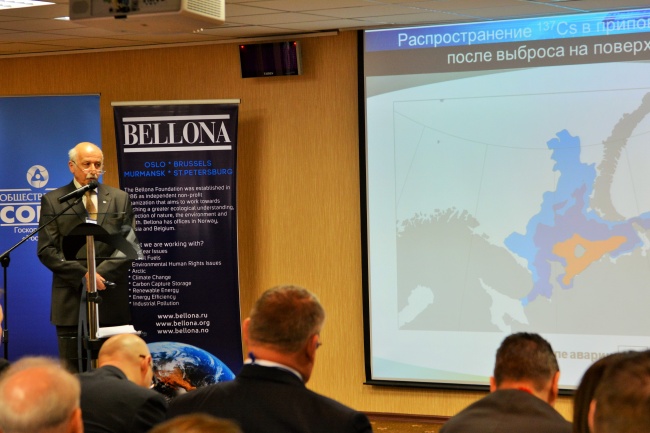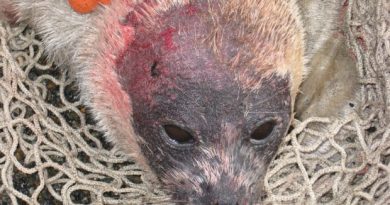Sunken Soviet submarines threaten massive radioactive contamination

While Russia’s naval yard in Severodvinsk is busy like never before in Post-Soviet times with construction of new submarines, two old submarines on the Arctic seabed cause major concern for nuclear scientists.
Russian scientists have made a worst-case scenario map for possible spreading of radionuclides from the wreck of the K-159 nuclear-powered submarine that sank twelve years ago in one of the best fishing areas of the Barents Sea.
Mikhail Korbinsky with the Nuclear Safety Institute of the Russian Academy of Science says the sunken November-class submarine can’t stay at the seabed. The two reactors contain 800 kilos of spent uranium fuel.
At a recent seminar in Murmansk organized jointly by Russia’s nuclear agency Rosatom and the Norwegian environmental group Bellona, Korbinsky presented the scenario map most fishermen in the Barents Sea would get nightmares by seeing.
Some areas could be sealed off for commercial fisheries for up to two years, Mikhail Korbinsky explained.
Ocean currents would bring the radioactivity eastwards in the Barents Sea towards the inlet to the White Sea in the south and towards the Pechora Sea and Novaya Zemlya in the northeast.
Important for fisheries
The Barents Sea is one of the most important Oceans in the world in regards to fisheries. Especially cod fisheries are important for Norway and Russia. Last year, the cod quota shared between the two countries was 993,000 tonnes.
The other submarine of great concern for the Russian scientists did not end up on the seabed by accident.
The K-27, put into service for the Northern fleet in 1963, was dumped in the Stepovogo Bay east of Novaya Zemlya in 1982. The sub had then been laid up for more than 15 years after one of the two troublesome reactors suffered a severe leakage of radioactive gasses and inadequate cooling causing extensive fuel element failures.
Dumping the entire submarine at sea was done in what the Soviet reactor engineers and scientist believed would be a safe way to avoid leakages of radionuclides to the marine environment.
Not so any more.
An uncontrolled chain reaction would be “quite serious, but not catastrophic,” Korbinsky explained.
Isolation is not good enough
“A study we have done indicates that only five to six litres of sea water into the reactor core are enough to trigger an uncontrolled chain reaction,” says Mikhail Korbinsky with the Nuclear Safety Institute of the Russian Academy of Science.
Korbinsky has, together with scientists from the Kurchatov Institute, studied how the isolating mixture of furfuryl and bitumen filled into the reactor before sinking now could dissolve much faster than originally thought.
K-27 has liquid metal cooled reactors, unlike most other submarine reactors that are water cooled. The scientists make their conclusion after studying another liquid metal cooled reactor, from the Alfa class fabric number 900 that for years was stored at the Zvezdockha yard in Severodvinsk. That reactor was also prepared for dumping with the same isolating mixture as K-27, but dumping was stopped as the Soviet Union decided to adapt to the London Convention prohibiting dumping of high level radioactive waste in the Oceans.
Dismantling the isolation on reactor 900 in Severodvinsk gave new insight suggesting a much more urgent condition for the K-27 than earlier believed.
“The isolation material used in the reactor compartment does not isolate as much as we thought,” he said.
Radioactivity could be airborne
“We have calculated that if an uncontrolled chain reaction happens, radioactivity could be releases to the air because the K-27 is dumped at a depth of only 30 metres,” Mikhail Korbinsky added. An uncontrolled chain reaction could trigger an explosion that might reach the surface.
If airborne, radioactivity will be spread much faster and over much longer distances than in water. The damaged reactor contains highly enriched uranium.
Earlier, Norwegian and Russian scientists making worst-case risk-assessments for K-27 have suggested that possible leakages would stay in the marine environment.
An uncontrolled chain reaction would be “quite serious, but not catastrophic,” Korbinsky explained.
Two years ago, a Norwegian-Russian joint study expedition to the dump site of K-27 concluded that it is feasible to lift the ill-fated submarine from the seabed. Although dumped 30 years ago, the hull of the submarine is intact.
“No corrosion damage of the outer hull was visible, Hilde Elise Heldal with the Norwegian Institute of Marine Research told BarentsObserver after the expedition.
Nils Bøhmer with the Bellona Foundation in Oslo is deeply concerned by the new information.
Urgent to prepare for lifting
“This new information from the Russian scientist suggesting that a chain reaction in K-27 can lead to radioactive emission to air, and that emission from K-159 could lead to restrictions on fisheries in parts of the Barents Sea, is very worrisome, Bøhmer says to BarentsObserver.
He urges Norwegian authorities to follow up this new information by contacting Russian authorities. “It is urgent to make preparation plans and risk assessments on how to raise these two submarines,” Nils Bøhmer adds.
At the seminar in Murmansk earlier in April, Andrey Kramorenko, expert with the Defence Ministry’s Institute of Rescue and Undersea Technologies said there are several ways the K-27 could be lifted.
“Russia has extensive experience in lifting sunken objects,” Kramorenko said, showing slides of how the K-27 could be taken safely back to a yard by using cranes, underwater jack-ups, or lifting the sub to underneath a barge like was done when the Russian navy cooperated with the Dutch salvage company Mammoet-Smit on lifting the “Kursk” submarine that sank in the Barents Sea in August 2000.
Related stories from around the North:
Canada: “Dumpcano” costs mounting in Canada’s eastern Arctic, Radio Canada International
Finland: Police to probe Forssa waste disposal company, Yle News
Greenland: Study finds increase in litter on Arctic seafloor, Blog by Mia Bennett
Norway: Norway is polluting Murmansk says Russian official, Barents Observer
Russia: Submariners feed polar bears with garbage, Barents Observer
Sweden: Sweden imports more and more waste, Radio Sweden
United States: Cleanup completed on 6 Arctic legacy wells in Alaska, Alaska Dispatch



